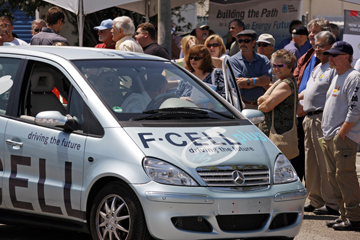
Ordinarily, you don’t see people lining up to test-drive cars, but Thursday, May 28, was not just any day in Livermore. A crowd of more than 100 people gathered downtown for the opportunity to get behind the wheel of hydrogen fuel cell-powered vehicles from major automakers including Honda, Toyota, Nissan, Volkswagen, and GM.
This was the 10th stop on the Hydrogen Road Tour, an eight-day event organized by the California Air Resources Board, California Fuel Cell Partnership, National Hydrogen Association, US Fuel Cell Council, and Powertech Labs (on behalf of British Columbia).
“The purpose is to show the public that hydrogen fuel cell cars are not decades away from market,” says Chris White of the California Fuel Cell Partnership.
Sandia organized the Livermore stop in partnership with the City of Livermore and Livermore Downtown Inc.
“We are honored to be part of this event. Sandia has been involved in hydrogen research for well over 45 years and hydrogen energy since about 1994,” says Jay Keller (8367), hydrogen program manager. “Our hard work has helped put these vehicles on the road today.”
The road tour brought out a diverse crowd that included scientists, auto enthusiasts, and the simply curious. Pleasanton resident Dan Stewart pulled his two sons out of school for a few hours to check out the road tour, and at the urging of 15-year-old Clint, signed up to test-drive one of the cars.
“I think it would be really cool to use hydrogen to power a car,” says Clint, a high school sophomore. “It would be much better for the environment.”
Livermore Police Officer Mony Nop also paid a visit. “I’m really excited to see so many different kinds of cars. I thought it would be just one company,” he says. “These seem like great vehicles. I talked with one guy about how fast he was able to drive — I won’t mention the exact speed to keep him out of trouble.”
Transportation Energy Center 8300 Director Bob Carling, Metal Hydrides Center of Excellence Director Lenny Klebanoff (8367), Terry Johnson (8365), Daniel Dedrick (8365), and other Sandia staff members came out to the road tour. Lenny spent time among the crowd answering questions about hydrogen fuel cells in general and Sandia’s program.
The cars don’t look much different from other cars on the road — which was exactly the point. Larry Goltz, a Livermore insurance agent, pointed out one key distinction. “Look what’s coming out of the tailpipe — water,” he says.
After driving a Honda FCX Clarity for about a quarter-mile around downtown, Goltz was ready to take it home. “I’d buy this car if I could. It’s a quiet, smooth, easy drive, but more important, I think this is our future. We need to stop importing fuel,” he says.
The FCX Clarity is one hydrogen fuel cell car you could very well see on the road, at least in Southern
California. Honda has begun leasing the car to customers in the Torrance, Santa Monica, and Irvine areas at $600 per month, which includes maintenance.
“Right now there is limited infrastructure, so we’re targeting areas with hydrogen refueling stations,” says Kent Dellinger, a government relations manager with Honda. “We’re hoping this tour will get the attention of our legislators, to show that fuel cell vehicles are not the distant future, they are now.”
Honda is not alone in the fuel cell car marketplace. Toyota has said that it will be selling fuel cell cars by 2015, and Hyundai Motor Co. and Daimler AG both have plans for selling hydrogen vehicles to retail customers.
“If you listen to those directly responsible for selling hydrogen fuel cell vehicles to the consumer, it seems clear that commercialization and marketability of these vehicles is moving a lot faster than we anticipated,” says Jay.
Progress in hydrogen R&D is real and significant
According to the California Fuel Cell Partnership, the hydrogen research community has consistently met or exceeded the DOE Hydrogen Program’s ambitious goals for energy efficiency, vehicle range, system durability, and reduced costs. Sandia, says Jay, has been involved in several key advances.
“Through our safety, codes, and standards work, we’ve been instrumental in the National Fire Protection Association’s rewriting of the model codes that local municipalities need to put hydrogen in commercial applications,” he explains. “This is not insignificant, as those agencies now have formal, written safety codes that allow them to work hydrogen into their commercial infrastructure.”
In fact, Jay does not see the infrastructure — refueling stations — as the major obstacle to bringing fuel cell cars to market. He says changing the infrastructure of the fleet poses a bigger challenge.
In addition, DOE’s Metal Hydride Center of Excellence (MHCoE), led by Sandia, continues to make progress finding a suitable new material that can soak up and concentrate hydrogen into a small volume, release the hydrogen when needed, and then repeat this cycle over and over for vehicular applications.
As the lead organization for the MHCoE effort, Sandia coordinates the work of some 18 organizations engaged in several promising areas of research. Sandia also is contributing to materials development work and helping direct research by refining materials theory.
Finally, Sandia’s work on a hydrogen internal combustion engine — considered a transition strategy designed to pave the way toward fuel cell vehicles — is supported by both Ford and BMW.
Road tour grabs media attention
Potential drivers weren’t the only ones lining up to check out the hydrogen fuel cell cars in Livermore — major media outlets also were out in force. Reporters from KQED’s Quest, the Valley Times, and San Francisco Chronicle all took test drives and the event was featured on prime-time news broadcasts on CBS, NBC, and ABC. For more on the Hydrogen Road Tour, visit www.hydrogenroadtour.com.